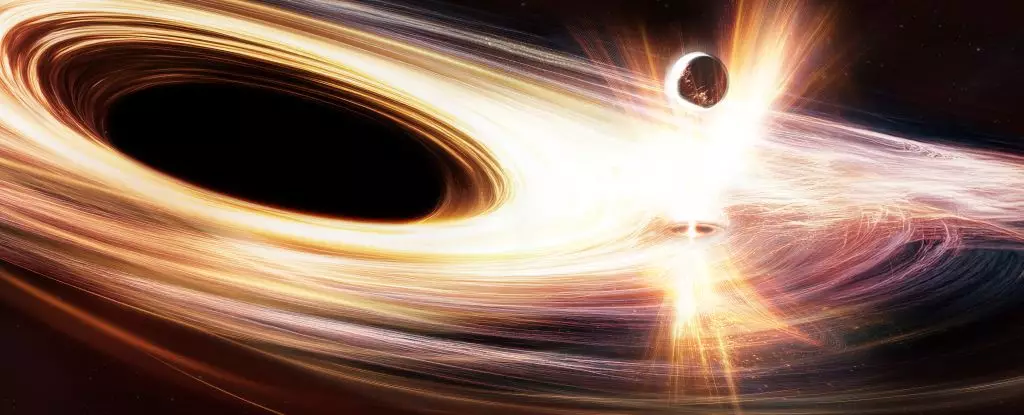Astrophysics has always been a domain filled with intrigue and wonder, and the discovery of a supermassive black hole, dubbed Ansky, located 300 million light-years away, has set the scientific community into a frenzy of excitement and speculation. Situated at the heart of the galaxy SDSS1335+0728, Ansky has shifted from a dormant state into a period of astonishing activity since 2019. Researchers have documented this transition in real-time, observing an unprecedented series of luminous eruptions that challenge our foundational understanding of black holes.
The phenomenon surrounding Ansky exemplifies a rich narrative beyond the simplistic notion of black holes as cosmic vacuum cleaners. Traditionally, these massive entities have been perceived as consuming all nearby matter, their gravitational influence drawing in stars, gas, and dust. However, the complexity lurking within their mechanics and behavior is far more nuanced. Ansky, with its unique characteristics and extraordinary energy output, prompts a profound reconsideration of how we perceive both black holes and their influence on the galaxies that host them.
Unprecedented Eruptions: A New Paradigm
Astrophysicists are baffled by the sheer scale of Ansky’s emissions. As highlighted by MIT astrophysicist Joheen Chakraborty, the X-ray bursts from Ansky not only exceed typical quasi-periodic eruptions in duration and luminescence but also release energies vastly beyond anything previously recorded. Each eruption generates approximately a hundred times more energy, displaying a regularity that spans about 4.5 days—an outlier in our understanding of black hole activity.
Such extreme behavior pushes scientific models to their limits, challenging researchers to rethink the mechanisms behind these violent outbursts. The issue becomes increasingly complicated when considering the interactions between black holes and their surrounding environments. Scientists have traditionally theorized that quasi-periodic eruptions occur when smaller celestial objects venture too close to a supermassive black hole, becoming ensnared in its gravitational web and igniting a chain reaction of flares. However, Ansky seems to contradict this model. Its bright emissions across various wavelengths—from infrared to X-rays—defy existing explanations and beckon new theories to the forefront of astrophysical research.
A Black Hole’s Dual Nature: Active vs. Dormant
The duality of black hole behavior—oscillating between periods of intensive activity and relative dormancy—has always intrigued astronomers. Take, for instance, Sagittarius A*, the supermassive black hole at the center of our own Milky Way, which currently exhibits a stable, quiet state. The understanding that black holes can transition between these states is not just an academic exercise; it has implications for how we grasp the evolution of black holes and their host galaxies. The observable interplay between accretion and quiescence is pivotal in determining how galaxies form and change over time.
Ansky offers a unique vantage point into this dynamic process. Being the first supermassive black hole documented “waking up” in real-time signifies a monumental achievement in observational astronomy. As stated by astronomer Lorena Hernández-García from the Millennium Institute of Astrophysics, this groundbreaking observation is an essential evolutionary step for our understanding of these cosmic giants and the intricate relationships they maintain with their galactic surroundings.
Future Implications for Gravitational Wave Research
Ansky’s extraordinary activity does not just raise questions concerning black hole mechanics; it also opens the door to potential gravitational wave research. The idea that the periodic eruptions may be intertwined with gravitational waves introduces a captivating twist to Ansky’s narrative. As observed by Erwan Quintin of the European Space Agency, these eruptions may provide valuable insights that future missions, like ESA’s LISA, will help elucidate.
Gravitational waves hold the key to unlocking countless mysteries in astrophysics. Understanding their connection to black hole activity can revolutionize how we monitor cosmic events. If Ansky’s eruptions indeed correlate with gravitational waves, then the findings could spur a paradigm shift not only in black hole studies but also in our comprehension of the universe’s most violent and energetic phenomena.
As we continue to delve deeper into the phenomena surrounding Ansky, it’s essential to embrace the excitement of the unknown. Will we be able to decode the secrets hidden within this unusual black hole and its explosive activity? The fact that Ansky is defying pre-established models serves as a reminder that our journey into understanding the universe is far from over. Each revelation about Ansky sparks new inquiries that could illuminate paths into uncharted territories of space cosmology, astrophysics, and beyond. The story of Ansky is more than a singular discovery; it embodies the ever-evolving quest for knowledge that defines the science of our time.


Leave a Reply